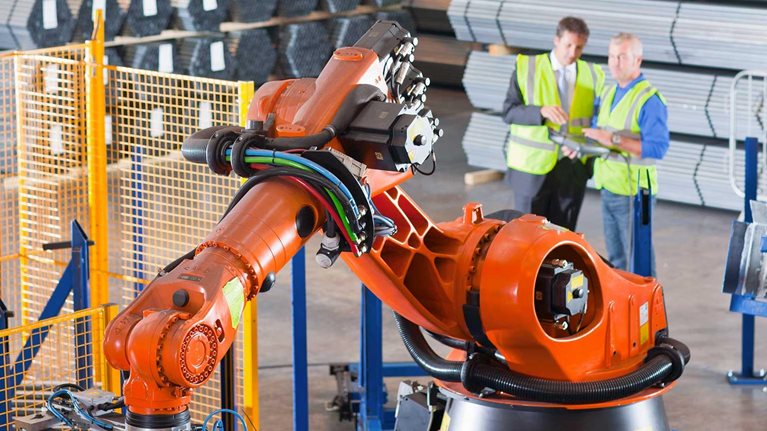Long before COVID-19 came to dominate our lexicon and our lives, the United States’ growth model was showing signs of strain.
With years of uneven growth across sectors and geographies, some industries have flourished while others have faltered. Major hubs have boomed, but countless smaller communities have fallen through the cracks. The labor market has become increasingly polarized, with the number of people in high- and low-wage jobs growing, while the number of people in middle-wage jobs has declined.
These forces have stoked inequality, and the pandemic has served only to exacerbate this trend. If we do not act, more people will be left behind and the US economy will suffer for it.
Manufacturing: A key part of the solution
Revitalizing US manufacturing—an industry that was once the beating heart of the country’s economy—could be fundamental to resolving these inequities while driving sustainable, inclusive growth.
Today, the manufacturing sector represents just 10 percent of US GDP and jobs but drives 20 percent of the nation’s capital investment, 35 percent of productivity growth, 60 percent of exports, and 70 percent of business R&D expenditure.
Despite its outsize contribution to the economy, manufacturing has not enjoyed the same prosperity as other sectors in recent years. While it has grown in absolute terms, its relative global share has dropped to 17 percent, from 25 percent, in the past two decades.
As manufacturing has declined, inequality has increased. Today, the United States bears the title of the most unequal economy in the G-7.
Research from the McKinsey Global Institute found that restoring growth and competitiveness in 16 key manufacturing industries could boost annual GDP by more than 15 percent. Strengthening the sector could also address the pervasive supply chain issues wreaking havoc all over the world, easing short-term disruption caused by the pandemic while improving global competitiveness in the mid- to long term.
A social and economic unlock
The manufacturing sector is full of companies driving significant shareholder value. Investors and capital markets should start paying attention.
Renewing capital stock in US manufacturing could help the industry realize its full potential and get billions of dollars of investment flowing. This would not only serve to modernize and digitize manufacturing infrastructure but also trigger a virtuous cycle of increased economic activity in communities across the country.
Bolstering investments in this sector could also play a major role in tackling place-based inequalities from coast to coast—especially in communities left out of the booming tech and finance industries.
Already, manufacturing is the main economic engine and primary employer in approximately 500 counties across the nation. In those communities, the industry employs a broader swath of the overall population—and it does it more inclusively. In most cases, employees don’t need a four-year degree, and they enjoy higher salaries than service jobs, making manufacturing a key tool to unlocking more opportunities for more people. These counties give us a blueprint for success.
Reviving manufacturing could also add up to 1.5 million jobs, particularly among middle-skill workers, helping to recalibrate the US labor market and bolster the middle class.
Revitalizing manufacturing means revitalizing communities.
The imperatives for growth
Realizing the benefits of a dynamic manufacturing industry will require a dual focus on modernization and workforce development.
The industry is undergoing seismic shifts toward a digital, automated, advanced, and sustainable future, but many smaller companies lack the tools they need to keep up. It will take innovation and participation across the economy to deliver these businesses the people and capital they need to thrive. Private- and public-sector leaders can play a role in modernizing smaller manufacturing operations by offering financial programs and targeted business accelerators.
As digitization takes hold, manufacturing must draw more talent into the pipeline and develop the skills of its existing workforce.
There are a record number of open jobs in US manufacturing today. In October last year, that figure topped one million—the highest on record and more than the entire population of San Francisco.
Attracting new talent will require strengthening the industry’s reputation among workers. To this end, companies should engage with schools and communities through university partnerships and trade school funding. In doing so, they will draw young people to the industry’s innovations and the advantages it provides workers, perhaps most importantly its viable jobs with opportunities for career progression.
But attracting new entrants to the workforce alone will not be enough—skill building for existing workers, particularly in digitization, must also be a priority. Without this, the chasm between the capabilities that people have today and those that many vacant jobs require will only widen. Coupled with the right worker training, digitization can help make the workforce more productive, their work more enjoyable, and the industry more competitive.
A moment of opportunity
The stars could soon align. The public and private sectors are increasingly resolved to shore up an industry that has long been a pillar of the United States’ economic fabric.
The manufacturing sector is primed to resume its position as a powerhouse of the economy, but leaders must focus their collective energy on three actions:
- urging investors and capital markets to turn their attention to manufacturing
- enticing new talent and training the workforce for tomorrow’s jobs
- updating and digitizing the US manufacturing infrastructure
If the manufacturing industry capitalizes on this opportunity by investing in innovation and workforce development, the gains will propel sustainable and inclusive growth while simultaneously fueling the United States’ competitiveness on the global stage.


